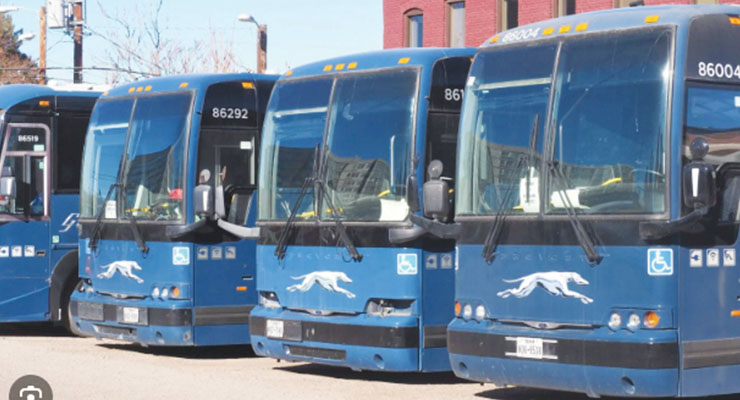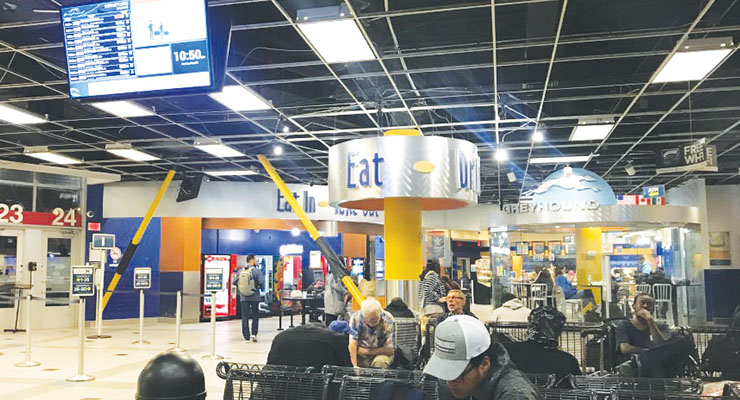By Ava O’Malley
DePaul University’s Chaddick Institute of Metropolitan Development recently released an eleven-page brief asking the City to save the Greyhound bus station at 630 W. Harrison St. The station’s private owners recently put the property, located on the southeastern edge of the newly configured 34th Ward, up for sale.
“We had heard disturbing reports about the fate of the Chicago station and felt the public needed to know,” said Joseph P. Schwieterman, director of the Chaddick Institute for almost 25 years and co-author of the brief.

Many inner city bus stations are privately owned, putting them at a higher risk of being sold, moved, or redeveloped. “Inner city bus stations are now an endangered species because of the interest of the owners in selling the land for development,” said Schwieterman.
German transportation company FlixMobility purchased Greyhound Lines from UK-based FirstGroup in 2021. This move was a big step for the Munich-based enterprise, which previously had limited acquisitions to continental Europe. When Flix purchased Greyhound, however, it did not buy the stations–just the fleet of buses and technology systems and the services of the operators.
Twenty Lake Holdings, a Connecticut real estate firm known for buying up newsrooms and office spaces, purchased the Harrison Street station with 32 other Greyhound properties for $140 million. Afterward, Twenty Lake quickly put the Chicago station, which spans 88,000 square feet, back on the market with help from CBRE Group, a global real estate company with several Chicago offices. CBRE estimates the station could sell in the low to mid $20 million range.
With the station on the market, the likelihood of its being redeveloped into residential towers, commercial space, or office buildings is high due to its proximity to downtown and the West Loop’s multifamily residential market.
Without a formal station, Greyhound passengers would have to resort to curbside service and no longer have a climate controlled shelter to wait in between trips. The Chaddick Institute’s brief, entitled Bus Station on the Brink, urges Chicago policymakers to consider acquiring the station and “operating it in a manner like public airports, railroad stations, and transit hubs.”
A graduate research assistant at DePaul’s Chaddick Institute, Angelia Milsap, assisted with data analytics and transportation research for the brief, which states that around 65% to 70% of Greyhound riders had annual household incomes less than $40,000, while between one-third and 38% made less than $20,000 annually. Millsap emphasized the importance of the station’s inner city location.
“The research shows that this station serves an underserved population, cost burdened households and families,” said Millsap, who studies sustainable urban development and metropolitan development.
West Loop weighs in
Some West Loop residents have grown wary of the bus station’s presence and hope to see the space redeveloped if sold.
“The fact that it’s in our residential community in Chicago indicates that maybe it’s not exactly in the right place,” said new 34th Ward Alderman Bill Conway, who added that, if the station “is going to go into private use, residences seem like the obvious place based on our city’s housing needs.”

Greyhound bus users worry that without the Harrison Street terminal they will be forced to wait for buses in extreme heat and cold and snowy conditions.
According to Conway, residents have voiced concerns about various crimes in the area around the Greyhound station. On Oct. 24, 2022, Rodnee Miller, a passenger who arrived at the station from Minneapolis, allegedly shot and killed 30-year-old Greyhound employee Duwon Gaddis. Miller waited at the station for Gaddis to arrive before shooting him, according to the police, who believe the incident was a gang-related murder.
Yet some West Loop residents such as Julie Darling, a West Loop Community Organization board member, see the station as an integral part of the community.
“Our community travels for work,” Darling explained. “It uses major forms of transportation, from the el stops to the train stations to Greyhound. We have a lot of transient nurses that travel through, we have doctors that travel through and so forth. So to lose one of the modes of transportation would only harm the community.”
Darling stated WLCO favors responsible development, meaning the group wants the station moved to an equally accessible space if the property sells. If the station becomes residential towers, she hopes the City would develop more public greenspaces in order to make up for this loss.
“If you’re going to put up a development, then you’re going to have to offset it with more green space to keep up with the demand of people,” she said. “If not, we’re just going to be like New York with a bunch of highrises.”
“I think that we do need to find alternate locations, hopefully something that can be a little bit more multimodal, and hopefully we can work together with the city and get CTA involved,” Conway said.
What’s at stake
Due to its Midwestern location, the Chicago Greyhound station serves as a connecting point for several other bus routes. According to the brief, annual traffic volume at the station ranges between 456,000 and 557,000 riders. As the country recovers from the pandemic, which officially phased out of being a public health emergency on May 11, the Chaddick Institute predicts Greyhound ridership will rise to 90% of pre-pandemic volumes.
“A lot of people of color, people of middle and low income who may not have another option to travel, are utilizing public transportation to get to a Greyhound station in order to be connected through the region,” Millsap said. “Without a downtown location, where it is so close in proximity to other forms of public transportation, a lot of the underserved populations that don’t have access to a car would definitely be impacted in their transportation options.
“This particular Chicago location is one of the busiest Greyhound stations,” Millsap added. “This is something that blew my mind when I learned it; if it were an airport, it would be in the top 185 busiest airports in the U.S. Sustainability wise, the average ridership per bus is almost 30 people. So that takes the equivalent of 15 to 16 cars off of the highways if you were doing double occupancy.”
Sustainability and Greyhound’s low ticket cost appeal to multiple demographics. Frank Kallmeyer, 23, was a Loyola University Chicago student from 2018 to 2020. A native Clevelander, Kallmeyer regularly rode buses from both Greyhound and Megabus, another bus transit firm, to travel between school and home. Kallmeyer estimates he took a bus around ten to twelve times, primarily between Chicago and Cleveland.
Kallmeyer’s decision to ride Greyhound hinged on several factors. He did not have “a car, so driving was not an option,” he said. “I have environmental reservations on [flying] for a 45-minute long flight. I tried to take the Amtrak once, but it took 12 or 13 hours, which just did not work for me. The Greyhound provided a median of price and timeliness.”
Kallmeyer’s Greyhound trips to Chicago from Cleveland often took him to the Harrison Station. When riding Megabus, however, it would pick him up or drop him off on the corner of Clinton and Polk Streets, which has no shelter.
“We would have to wait outside on some 20 degree, snowy Chicago days,” Kallmeyer said.
According to Schwieterman, passengers have no clear alternative if Greyhound leaves the station. This situation may change, though, as the brief has captured the attention of elected officials and City planners.
“Disadvantaged populations have a huge stake in this,” Schwieterman said.
“Not only economically, but culturally, the bus is important to minority groups and the unemployed.”
For Conway, log on to www.chicago.gov/city/en/about/wards/34.html or email [email protected]. For Greyhound, log on to www.greyhound.com. For WLCO, log on to www.westloop.org.
